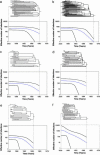Genetic analysis reveals the complex structure of HIV-1 transmission within defined risk groups
- PMID: 15767575
- PMCID: PMC555492
- DOI: 10.1073/pnas.0407534102
Genetic analysis reveals the complex structure of HIV-1 transmission within defined risk groups
Abstract
We explored the epidemic history of HIV-1 subtype B in the United Kingdom by using statistical methods that infer the population history of pathogens from sampled gene sequence data. Phylogenetic analysis of HIV-1 pol gene sequences from Britain showed at least six large transmission chains, indicating a genetically variable, but epidemiologically homogeneous, epidemic among men having sex with men. Through coalescent-based analysis, we showed that these chains arose through separate introductions of subtype B strains into the United Kingdom in the early to mid-1980s. After an initial period of exponential growth, the rate of spread generally slowed in the early 1990s, which is more likely to correlate with behavior change than with reduced infectiousness resulting from highly active antiretroviral therapy. Our results provide insights into the complexity of HIV-1 epidemics that must be considered when developing HIV monitoring and prevention initiatives.
Figures



References
-
- Murphy, G., Charlett, A., Jordan, L. F., Osner, N., Gill, O. N. & Parry, J. V. (2004) AIDS 18, 265–272. - PubMed
-
- Holmes, E. C., Nee, S., Rambaut, A., Garnett, G. P. & Harvey, P. H. (1995) Philos. Trans. R. Soc. London B 349, 33–40. - PubMed
-
- Nee, S., Holmes, E. C., Rambaut, A. & Harvey, P. H. (1995) Philos. Trans. R. Soc. London B 349, 25–31. - PubMed
-
- Griffiths, R. C. & Tavare, S. (1994) Philos. Trans. R. Soc. London B 344, 403–410. - PubMed
Publication types
MeSH terms
Associated data
- Actions
- Actions
- Actions
- Actions
- Actions
- Actions
- Actions
- Actions
- Actions
- Actions
- Actions
- Actions
- Actions
- Actions
- Actions
- Actions
- Actions
- Actions
- Actions
- Actions
- Actions
- Actions
- Actions
- Actions
- Actions
- Actions
- Actions
- Actions
- Actions
- Actions
- Actions
- Actions
- Actions
- Actions
- Actions
- Actions
- Actions
- Actions
- Actions
- Actions
- Actions
- Actions
- Actions
- Actions
- Actions
- Actions
- Actions
- Actions
- Actions
- Actions
- Actions
- Actions
- Actions
- Actions
- Actions
- Actions
- Actions
- Actions
- Actions
- Actions
- Actions
- Actions
- Actions
- Actions
- Actions
- Actions
- Actions
- Actions
- Actions
- Actions
- Actions
- Actions
- Actions
- Actions
- Actions
- Actions
- Actions
- Actions
- Actions
- Actions
- Actions
- Actions
- Actions
- Actions
- Actions
- Actions
- Actions
- Actions
- Actions
- Actions
- Actions
- Actions
- Actions
- Actions
- Actions
- Actions
- Actions
- Actions
- Actions
- Actions
- Actions
- Actions
- Actions
- Actions
- Actions
- Actions
- Actions
- Actions
- Actions
- Actions
- Actions
- Actions
- Actions
- Actions
- Actions
- Actions
- Actions
- Actions
- Actions
- Actions
- Actions
- Actions
- Actions
- Actions
- Actions
- Actions
- Actions
- Actions
- Actions
- Actions
- Actions
- Actions
- Actions
- Actions
- Actions
- Actions
- Actions
- Actions
- Actions
- Actions
- Actions
- Actions
- Actions
- Actions
- Actions
- Actions
- Actions
- Actions
- Actions
- Actions
- Actions
- Actions
- Actions
- Actions
- Actions
- Actions
- Actions
- Actions
- Actions
- Actions
- Actions
- Actions
- Actions
- Actions
- Actions
- Actions
- Actions
- Actions
- Actions
- Actions
- Actions
- Actions
- Actions
- Actions
- Actions
- Actions
- Actions
- Actions
- Actions
- Actions
- Actions
- Actions
- Actions
- Actions
- Actions
- Actions
- Actions
- Actions
- Actions
- Actions
- Actions
- Actions
- Actions
- Actions
- Actions
- Actions
- Actions
- Actions
- Actions
- Actions
- Actions
- Actions
- Actions
- Actions
- Actions
- Actions
- Actions
- Actions
- Actions
- Actions
- Actions
- Actions
- Actions
- Actions
- Actions
- Actions
- Actions
- Actions
- Actions
- Actions
- Actions
- Actions
- Actions
Grants and funding
LinkOut - more resources
Full Text Sources
Medical
Molecular Biology Databases

